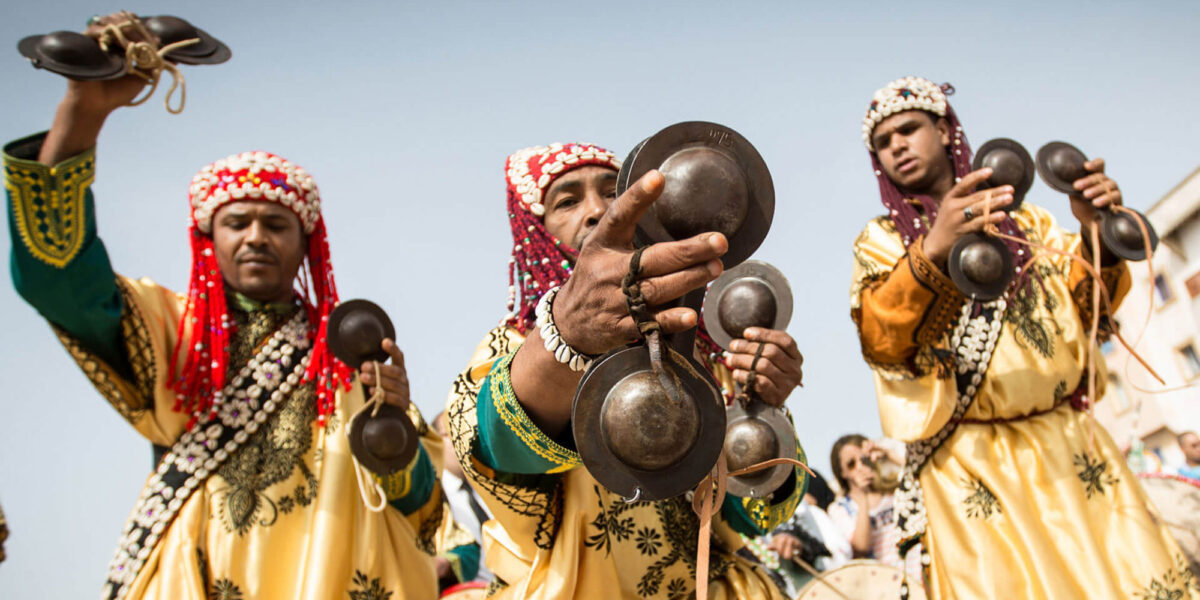In the captivating land of Morocco, music and dance hold a profound place in the hearts of its people. From the mesmerizing rhythms of Gnawa to the lively movements of belly dance and the spirited folk dances like Ahidous and Raïs, Moroccan music and dance form an integral part of the country’s rich cultural heritage. Let’s embark on a journey to explore the enchanting world of Moroccan music and dance, delving into their cultural
significance and their role in Moroccan society.
Moroccan music is a vibrant mosaic of diverse influences, blending Berber, Arab, African, and Andalusian traditions. Traditional instruments like the oud (a stringed instrument), the guembri (a three-stringed bass lute), and the qraqeb (metal castanets) create a distinctive sound. From soul-stirring songs of longing and love to joyful melodies that accompany celebrations and festivals, Moroccan music weaves stories of the country’s history, traditions, and daily life.
- The mystical rhythms of Gnawa: with its entrancing beats and spiritual undertones, holds a special place in Moroccan culture. Rooted in African and Sufi traditions, Gnawa music combines soulful chants, rhythmic drumming, and the distinctive sound of the guembri. Gnawa rituals, known as “lilas,” are ceremonies where musicians and devotees come together to evoke spiritual healing and trance-like states through music and dance.
- Belly Dance, the art of expressive movement: Known as “raqs sharqi,” is an enchanting and expressive dance form that originated in the Middle East and North Africa, including Morocco. It is characterized by graceful movements of the hips, fluid arm movements, and intricate isolations of different body parts. In Morocco, belly dance has its own unique style, blending elements of Berber and Arab traditions. It is not only a form of entertainment but also a celebration of feminine beauty and a reflection of Moroccan cultural identity.
- Folk Dances, celebrating traditions: Morocco’s folk dances are an exuberant celebration of community and heritage. Ahidous, a group dance performed by the Berber tribes of the Atlas Mountains, showcases synchronized movements, rhythmic clapping, and foot-stomping. Raïs, another popular folk dance, originates from the coastal regions and features energetic movements accompanied by lively music. These traditional dances are often performed during weddings, festivals, and cultural gatherings, serving as a way to pass down traditions from one generation to the next.
In Moroccan society, music and dance go beyond entertainment. They are vehicles for cultural expression and communication. They serve as a means to express emotions, tell stories, and reinforce social bonds. From religious ceremonies and spiritual rituals to everyday celebrations and gatherings, music and dance permeate Moroccan life, bringing communities together and preserving cultural traditions.
Moroccan music and dance have not only captivated the hearts of Moroccans but have also made their mark on the global stage. Artists like Nass El Ghiwane, Oum Kalthoum, and Cheb Khaled have brought Moroccan music to international audiences, blending traditional sounds with contemporary influences. In recent years, Moroccan music festivals, such as the Essaouira Gnawa and World Music Festival, have gained prominence, attracting artists and music lovers from around the world.
Beyond entertainment, music and dance play a vital role in Moroccan society, serving as vehicles for cultural expression, storytelling, and community bonding. They preserve traditions, celebrate occasions, and serve as a bridge between generations. So, immerse yourself in the captivating world of Moroccan music and dance, and let its enchantment
transport you to a realm where culture comes alive through melody and movement.

2 kommentarer til “Moroccan Music and Dance: Rhythms that Enchant the Soul”
Great web site. Lots of helpful information here. I am sending it to some buddies ans also sharing in delicious. And obviously, thanks on your sweat!
Just what I was searching for, appreciate it for posting.